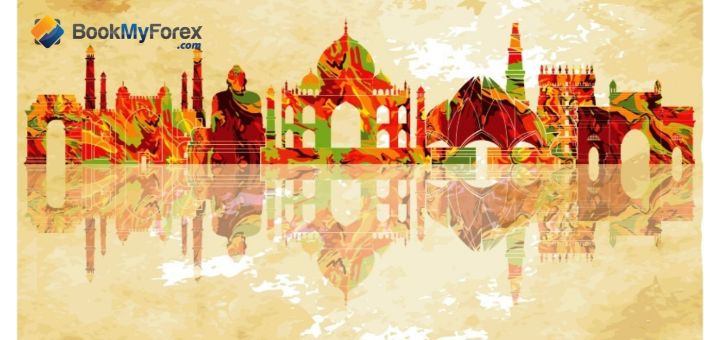Indian Tourism Has the Potential to contribute 25% to our GDP…
Indian Tourism Growth is in India’s Villages
15.5 million foreign tourists including Non-Resident Indians(NRIs) visited India in 2017. While as Asia-Pacific region saw 323 million foreign tourists arrivals in the same year. Countries like Japan, Thailand, Hong Kong, Malaysia, Macau and China had more Foreign Tourist Arrivals than India. These numbers are getting better for India – but when compared with, say, Macau, which received 17.3 million tourists last year, you may wonder why a country with 29 states and 4,000 cities managed to attract so few foreign travellers? India is one of the least touristy destinations according to Priceonomics¹, figuring at the number 4 in the top 10 list. The other countries on the list are Bangladesh, Moldova, Guinea, Niger, Sierra Leone, Chad, Ethiopia, Mali etc. That is a huge surprise for the world’s 4th largest economy.
In 2016, travel and tourism contributed $208 billion, or 9.6% of India’s GDP, and supported over 40 million jobs, 9.3% of the country’s total employment. The tourism sector is predicted to grow at an annual rate of 6.7% to $420 billion by 2027 (around 10% of GDP) (The World Travel & Tourism Council)
However, there exists the potential to increase this growth rate to 30% – and when that happens tourism will contribute around 25% of our GDP.
Indian Tourism Can Contribute 25% to GDP in the next 10 years.
Indian tourism has the potential to contribute 25% to India’s GDP according to the World Economic Forum. This growth, however, will not come from traditional tourist destinations but from India’s 600,00 villages. WEF notes that “India’s Villages represent an ocean of heritage, culture and experiences waiting to be explored. Yet to unlock the hidden potential of India’s villages, India needs to approach the issue through the lens of impact tourism. The village-based impact tourism model can boost tourism by $25 billion by bringing 15 million extra tourists to villages alone, creating 100,000 village-level entrepreneurs in the process.”
Can Indian Tourism Save Rupee from Depreciating?
In recent months there has been a debate about the Rupee losing value against Dollar. Critics feel that Rupee is weakening. While as the rupee is losing value against Dollar, it has performed better against other currencies especially the emerging market currencies. The dollar is strong because of the lowering of the interest rates by the Federal Bank of America. While as Rupee will keep losing its value unless we make Rupee stronger or we increase our Forex reserves.
According to the World Travel and Tourism Council’s economic report of 2018, “Travel & Tourism contributes 10.4% of global GDP and 313 million jobs or 9.9% of total employment, in 2017”. Here is a quick glance of the key facts regarding the economic impact of tourism and travel in India by WTTC.
Tourism – the great foreign exchange earner.
Travel & Tourism is an important economic activity in most countries around the world. In addition to its direct economic impact, the industry has significant indirect and induced impacts. Travel & Tourism’s total contribution is much greater and aims to capture its indirect and induced impacts through its annual research.
The maximization of foreign exchange earnings is a high priority for most countries and in developing countries. It is often the primary objective of tourism policy. Tourism earnings are often the most effective, or even the only way to produce the foreign exchange needed for the import of goods and services essential for national economic growth” Wheatcroft, S. (1998) ‘The airline industry and tourism’. In: Ioannides, D. and Debbage, K.G. (eds) The economic geography of the tourist industry. London: Routledge, pp. 159-179
Economically Important And Growing Rapidly
The tourism industry of India is economically very important and is growing rapidly. India has always earned more from travel and tourism than spent on foreign travel by Indians. But it’s time India starts paying attention to a clean environment and pollution control. For that India needs to boost infrastructure to attract tourism that is growing rapidly across the world and contributes significantly to the world economy. Although there are no alarm bells today, there are many middle-class Indians that go overseas on holidays due to better facilities and a clean environment. If urgent steps are not taken and in time, we might soon see more dollars spent by Indians from their overseas trips than what India can earn from foreigners visiting India.
The World’s Most Visited Countries- India is at 13th.
According to the annual report published by the Ministry of Tourism, “Tourism is a major engine of economic growth and an important source of employment & foreign exchange earnings in many countries including India. It has a great capacity to create large-scale employment of diverse kind – from the most specialized to the unskilled and hence can play a major role in the creation of additional employment opportunities. It can also play an important role in achieving growth with equity and sustainability.”
The tourism industry of India is economically important and grows rapidly. The World Travel & Tourism Council gave India the third rank among countries with the fastest growing tourism industries over the next decade. India is the 13th most visited tourist destination even though we are the 5th largest economy in terms of GDP. There is tremendous opportunity to get this number up and the Indian government is working hard through its promotional campaigns like “Incredible India and Swachh Bharat”. The focus is to promote Indian tourism and establish India as a clean destination. If you look at Medical Tourism, India has a large medical tourism sector which is expected to grow at an estimated rate of 30% annually.
Incredible India and Swachh Bharat
If developed efficiently, Tourism—being a multi-segment industry—is an economic windfall for a country. There is the positive economic impact of Tourism like the generation of national income, developing new employment opportunities, tax revenue, generation of foreign exchange, and transformation of the regional economy. Countries around the globe treat Travel & Tourism an important economic activity. India saw this opportunity and developed its own marketing campaign called ‘Incredible India’. Incredible India (styled as Incredıble !ndıa) is the name of an international tourism campaign maintained by the Government of India since 2002, to promote tourism in India to an audience of global appeal.
Tourism Industry not only has a direct economic impact but significant indirect and induced impacts. India as a country is an ideal tourist destination because of its medley of different cultures, traditions, festivals, and places of interest. The options for the tourists in India is unparalleled. India is a country with rich cultural and traditional diversity. This aspect is even reflected in its tourism. The different parts of the country offer a wide variety of interesting places to visit. However, to jump into the top 10, India has to overcome the challenges in Tourism. And one of the biggest challenges that India faces is cleanliness.
Swachh Bharat Abhiyan.
Swachh Bharat Abhiyan (SBA) or Swachh Bharat Mission (SBM) is a nation-wide campaign in India for the period 2014 to 2019 that aims to clean up the streets, roads and infrastructure of India’s cities, towns, and rural areas. In English, Swachh Bharat means ‘Clean India Mission’. “Swachhta” is one of the pillars of tourism because a clean tourist place is more sustainable in the long run for Indian Tourism. A cleaner India will attract investment, good health and a sense of pride amongst the population. This will lead to a sense of satisfaction amongst the tourists. Considering the importance, Ministry of Indian Tourism has come up with its “Swachhta Action Plan” involving activities of awareness on cleanliness among tourist, school/college students, and stakeholders of tourist centres, pilgrimage centres & famous archaeological monuments. And also these activities are being implemented at 150 sites at selected 15 states in India during 2017-18.
Challenges that Indian Tourism Faces
The tourism industry in India is growing and it has vast potential for generating employment and earning a large amount of foreign exchange besides giving a boost to the country’s overall economic and social development. But much more remains to be done. There are challenges involved in the tourism industry and we have discussed them below:
1- Lack of Proper infrastructure:
Infrastructure needs for the travel and tourism industry range from physical infrastructures such as ports of entry to modes of transport to urban infrastructures such as access roads, electricity, water supply, sewerage and telecommunication. The sectors related to the travel and tourism industry include airlines, surface transport, accommodation (hotels), and infrastructure and facilitation systems, among others.
2-Access and connectivity:
The infrastructure facilities like air, rail, road connectivity and hospitality services still need to get better to connect various cities across the country. This remains a major issue for the development of tourism. Tourists largely depend on road network rather than other modes. Despite numerous efforts to modernize the road facilities connectivity remains a major challenge. There is a greater need to improve road and rail network to connect various locations across different regions in the country.
3-Amenities:
Amenities available at various tourist locations and road infrastructure need to be better. These include basic amenities such as drinking water, well maintained and clean waiting rooms and toilets, first aid and wayside such as lounge, cafeteria, and parking facilities, among others. India scores poorly in terms of availability of these infrastructure facilities. Inadequate infrastructure facilities affect inbound tourism and could lead to an increase in the outflow of domestic tourists from India to other competitive neighbouring countries.
4-Service Level:
To sustain growth in the tourism industry trained manpower is required at various levels such as managerial, supervisory, skilled or semi-skilled. At mid and senior management levels, the industry faces talent crunch and at the front-line staff level, although human resources are adequate, a boom in other service industries such as banking, retail, airline and BPO has resulted in the shortage of manpower at this level for the travel and tourism industry. Thus, we have a demand-supply mismatch with respect to manpower in the tourism sector in India. Attrition, shortage of tourism training infrastructure, qualified trainers, and lack of proper strategies and policies for human resource development also affects the industry. The industry needs to address these problems at the earliest.
5-Human Resources:
The degree of service offered by the various stakeholders has a significant impact on determining the tourist’s overall experience of India as a tourist destination. The government has taken initiatives to promote responsible tourism by sensitizing key stakeholders of the tourism industry through training and orientation. To have a sense of responsibility towards tourists and to inspire confidence over foreign tourists in India as a preferred destination. In India, we need to focus more to offer better services to make Indian Tourism a strong segment in International tourism.
6-Marketing & Promotion:
Marketing of Indian Tourism marketing needs a more competitive and modern approach. There is a need to develop a unique market position and the brand positioning will be the essence of the country’s tourism products to the potential customer. Promotion of Indian tourism products is primarily the job of the Ministry of Tourism with the involvement of state governments through the State Tourism Development Corporations. For any new thoughts exist in this sector it requires support to develop and flourish with the involvement of Government. India has a big opportunity in tourism to make it a better position to use and consider new strategy in marketing to close with domestic as well as global tourists.
7-Taxation:
India is an expensive tourist destination because of high taxes in the Indian Tourism industry. This is affecting the growth of the industry in India and India is losing out to other low-cost destinations. Different types of taxes are levied across the entire industry. From tour operators, transporters, airline industry to hotels. These include service tax, luxury tax, tax on transportation, tax on aviation turbine fuel (airline industry), and various taxes on transportation. In addition, these tax rates tend to vary across different states in the country. Obviously, this will be one of the challenges behind our sustainability in this sector.
8-Security:
Security has been a major problem for our growth in tourism for several years. Terrorist attacks or political unrest in different parts of the country have adversely affected sentiments of foreign tourists. However, the government needs to take a proactive approach in addressing these issues. As it can have a potential impact on the industry. Cyber-crime is another major challenge in the tourism industry. Use of Internet in the travel and tourism industry has increased rapidly in recent years. It has emerged as one of the major segments of online spends. The industry needs to take measures to make the process of online bookings more secure and transparent. There needs to be an awareness regarding this. We have seen an increase in fraudulent activities in this segment. The issue of online security is of significant importance in this regard.
9-Regulatory issue:
Tourism brings in huge revenues. Every country wants more tourists not only to earn but to build a positive image of their country. All of these countries compete with each other to bring in more tourists. So its highly important that India makes it easy for tourists to come here. Countries across the globe especially ones who get a higher number of tourists have easier visa processes like e-visa and visa on arrival. India has to provide easier processes visa on arrival and e-visa for more countries. Or have these visas for certain categories of tourists for a specific duration. Licensing and government approvals is a hassle in India. As plenty of projects in the tourism infrastructure segment and in the hotel industry face delays.
The government is working towards single window clearance for hotel projects to hasten the process of infrastructure development. It will immensely help in the development of tourism and hospitality infrastructure in the country if implemented well. Indian Tourism ministry needs to push for speedier clearances and approvals for all projects of the tourism industry.
Benefits to India: Economy
Benefits to India: Environment
The impact of tourism on the environment can have either beneficial or extremely detrimental effects. When a lively tourism industry induces the government to invest in national parks and preserves, the environment may benefit. Eco-tourism improves the chances of benefit to the environment on a small and large scale. In India, you can find hotels, tour groups, resorts and organized expeditions designed for eco-tourism. Practices may include efficient use of water and electricity or the implementation of recycling programs. Indian eco-tourism groups include Eco-Tourism Pioneers in Kerala (tourindiakerala.com) and Jungle Lodges and Resorts (junglelodges.com), located in South India.
Benefits to Visitors: Health Tourism
A minority of visitors to India are not travelling to see the sights. But instead, come to India to undergo medical treatments or operations. The relatively high quality of medical treatment in India, in comparison with the country’s low costs. It makes India a destination for many international tourists who cannot afford the medical costs in their own countries. Procedures such as heart surgeries, orthopaedic procedures, transplants, endoscopies, cosmetic surgeries and neurosurgeries are all common reasons for medical tourism. On average, the cost of one of these procedures in India is one-fourth that of a European country.
Socially Responsible Travel
Socially responsible travel although a new form of tourism focuses on social benefits to the host country. Typically, travel activities involve volunteerism or economic support for local communities. In India, few organisations run socially responsible programs. They combine the study of local efforts toward sustainable growth and development along with volunteer work. Some arrange volunteer work and home-stay situations, with the intention of bringing together varied cultures and socio-political backgrounds.
Types of Tourism & Potential Tourism Earners
It is indispensable for India’s tourism industry to develop and identify niche tourism Products. Indian Tourism Ministry had taken up this dynamic initiative of identifying, diversifying, developing and promoting niche products. A major challenge with Indian tourism is the seasonal tourist. And identifying and developing niche products will overcome the aspect of ‘seasonality’ and promote India as a 365 days destination. This will attract tourists with a specific interest. In fact, it will ensure repeat visits for the unique tourism products like Yoga in which India has a comparative advantage. The Ministry of Indian Tourism has constituted Committees for the promotion of Golf Tourism and Medical & Wellness Tourism. Indian tourism ministry will come up with guidelines and strategies to support Golf, Polo, Medical and Wellness Tourism.
Niche Tourism Products to develop and promote:
Developing niche tourism products is the priority for Indian tourism ministry. And, promoting them efficiently throughout the world will generate additional revenue and boost up Indian tourism numbers. So, the key niche tourism products that ministry is developing are:
—Cruise
—Adventure
—Medical
—Wellness
—Golf
—Polo
—Meetings Incentives Conferences & Exhibitions (MICE)
—Eco-tourism
—Film Tourism
Sources:
¹http://tourism.gov.in/sites/default/files/annualreports/Annual%20Report2017-18.pdf
-http://tourism.gov.in/sites/default/files/Other/INDIA%20TOURISM%20STATISTICS%202017.pdf
-https://www.wttc.org/-/media/files/reports/economic-impact-research/countries-2018/india2018.pdf
































Leave a Reply